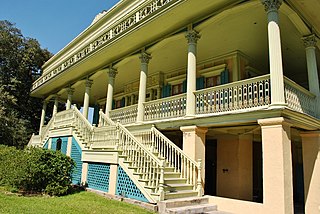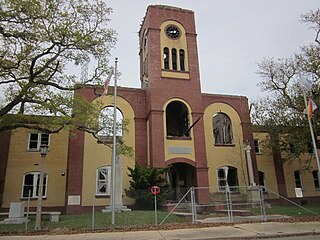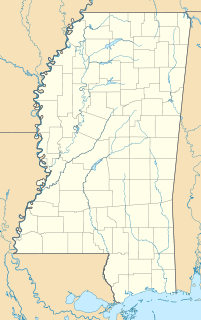
Desha County is a county located in the southeast part of the U.S. state of Arkansas, with its eastern border the Mississippi River. As of the 2010 census, the population was 13,008. It ranks 56th of Arkansas's 75 counties in terms of population. The county seat is Arkansas City. Located in the Arkansas Delta, Desha County's rivers and fertile soils became prosperous for planters under the cotton-based economy of plantation agriculture in the antebellum years and late 19th century. Still largely rural, it has suffered population losses and economic decline since the mid-20th century.

St. John the Baptist Parish is a parish located in the U.S. state of Louisiana. As of the 2010 census, the population was 45,924. The parish seat is Edgard, an unincorporated area, and the largest city is LaPlace, which is also unincorporated.

Plaquemines Parish is a parish located in the U.S. state of Louisiana. As of the 2010 census the population is 23,042. The parish seat is Pointe à la Hache and the largest community is Belle Chasse. The parish was formed in 1807.

Holly Springs is a city in and the county seat of Marshall County, Mississippi, United States, at the border with southern Tennessee. Near the Mississippi Delta, the area was developed by European Americans for cotton plantations and was dependent on enslaved Africans. After the American Civil War, many freedmen continued to work in agriculture but as sharecroppers and tenant farmers.

Greenville is a city in, and the county seat of, Washington County, Mississippi, United States. The population was 34,400 at the 2010 census. It is located in the area of historic cotton plantations and culture known as the Mississippi Delta.

The Mississippi Delta, also known as the Yazoo-Mississippi Delta, or simply The Delta, is the distinctive northwest section of the U.S. state of Mississippi which lies between the Mississippi and Yazoo Rivers. The region has been called "The Most Southern Place on Earth", because of its unique racial, cultural, and economic history. It is 200 miles (320 km) long and 87 miles (140 km) across at its widest point, encompassing about 4,415,000 acres (17,870 km2), or, almost 7,000 square miles of alluvial floodplain. Originally covered in hardwood forest across the bottomlands, it was developed as one of the richest cotton-growing areas in the nation before the American Civil War (1861–1865). The region attracted many speculators who developed land along the riverfronts for cotton plantations; they became wealthy planters dependent on the labor of black slaves, who composed the vast majority of the population in these counties well before the Civil War, often twice the number of whites.

Washington is an unincorporated community in Adams County, Mississippi, United States. The community is close to Natchez. Located along the lower Mississippi River, it was the second and longest-serving capital of the Mississippi Territory.

Tougaloo College is a private historically black college in Tougaloo, Mississippi. It is affiliated with the United Church of Christ and Christian Church. Originally established in 1869 by New York–based Christian missionaries for the education of freed slaves and their offspring, from 1871 until 1892 the college served as a teachers' training school funded by the state of Mississippi. In 1998, the buildings of the old campus were added to the National Register of Historic Places.

Woodlawn is a historic house located in Fairfax County, Virginia. Originally a part of Mount Vernon, George Washington's historic plantation estate, it was subdivided in the 19th century by abolitionists to demonstrate the viability of a free labor system. The address is now 9000 Richmond Highway, Alexandria, Virginia, but due to expansion of Fort Belvoir and reconstruction of historic Route 1, access is via Woodlawn Road slightly south of Jeff Todd Way/State Route 235. The house is a designated National Historic Landmark, primarily for its association with the Washington family, but also for the role it played in the historic preservation movement. It is now a museum property owned and managed by the National Trust for Historic Preservation.
Davis Bend, Mississippi, was a peninsula named after planter Joseph Emory Davis, who owned most of the property. There he established the 5,000-acre Hurricane Plantation as a model slave community. Davis Bend was about 15 miles south of Vicksburg, Mississippi, and was surrounded by the Mississippi River on three sides. He gave his much younger brother Jefferson Davis the adjoining Brierfield Plantation.
Torras is the name of a former town in the extreme northeastern corner of Pointe Coupee Parish, Louisiana, United States. The town was located along either side of the Texas & Pacific Railroad at its juncture with Lower Old River. The Mississippi River is located just to the east and the juncture of the Red and Atchafalaya Rivers just to the west.

Faunsdale Plantation is a historic plantation near the town of Faunsdale, Alabama, United States. The town was named for it, in honor of a late owner. This plantation is in the Black Belt, which was developed for cotton plantations. During the antebellum period, planters held as many as 186 enslaved African Americans at this property as laborers to raise cotton as a commodity crop.

Mississippi is a state in the Deep South region of the Southern United States, bordered to the north by Tennessee; to the east by Alabama; to the south by the Gulf of Mexico; to the southwest by Louisiana; and to the northwest by Arkansas. Mississippi's western boundary is largely defined by the Mississippi River. Mississippi is the 32nd largest and 34th-most populous of the 50 U.S. states. Jackson is both the state's capital and largest city. Greater Jackson is the state's most populous metropolitan area, with an estimated population of 580,166 in 2018.

Brierfield Plantation was a large forced-labor cotton farm in Davis Bend, Mississippi, south of Vicksburg and the home of Confederate president Jefferson Davis. The use of the plantation, with more than 1,000 acres, was given to Davis by his much older brother, Joseph E. Davis (1784-1870); it had previously been a part of Joseph Davis's much larger Hurricane plantation which it adjoined on a bend of the Mississippi River twenty miles from Vicksburg. With his brother's financial assistance and the forced labor of enslaved people, Jefferson Davis became a successful planter on the acreage following his brief first marriage to Sarah Knox Taylor ; after his second marriage to Varina Banks Howell in 1845, Davis erected a large comfortable frame house on the property that was home to himself, his wife, their children, as well as Davis's widowed sister and other relatives.

Annandale Plantation was a forced-labor cotton farm with an Italianate-style plantation house in what is now the Mannsdale neighborhood of Madison, Mississippi.

Mount Holly was a historic Southern plantation in Foote, Mississippi. Built in 1855, it was visited by many prominent guests, including Confederate President Jefferson Davis. It was later acquired by ancestors of famed Civil War novelist Shelby Foote, who wrote a novel about it. It burned down on June 17, 2015.
Concord was a historic mansion in Natchez, Mississippi. Built in 1789, it was the official residence of the Spanish Governors of Mississippi before it joined the United States. It was then acquired by the Minor family, who owned many Southern plantations, followed by a banker from New York. It burnt down in 1901.
The Sunnyside Plantation was a cotton plantation near Lake Village in Chicot County, Arkansas, in the Arkansas Delta region. Built as a cotton plantation in the Antebellum South, it was farmed using the forced labor of African American slaves. After the American Civil War of 1861-1865, freedmen farmed it. From the 1890s to the 1910s, it used convict laborers and employed immigrants from Northern Italy, many of whom were subject to peonage. They were later replaced by black sharecroppers. The plantation was closed down and it was broken up in the 1940s. Nowadays, only a historical marker reminds Lake Village residents and visitors of its history.

Leota is a ghost town located in Washington County, Mississippi, United States. The settlement, along with its river port Leota Landing, were at one time located directly on the Mississippi River.
Montpellier is a historic plantation house built as the main residence and headquarters of a forced-labor farm in Natchez, Mississippi. It was built in the 1840s in the Greek Revival architectural style for Charles Whitmore, an English-born planter and enslaver. It has been listed on the National Register of Historic Places since December 18, 1979.














